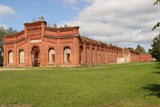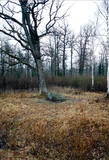| Nr | Nosaukums | Apraksts |
|---|---|---|
|
Zemnieku saimniecība "Mežnoras" Raunā izveidota 1993.gadā. Saimnieki Aivars, Ārija un Līga Urbasti šobrīd audzē 1,6 ha vasaras un rudens avenes, arī nelielās platībās zemenes uz lauka un segtās platībās, siltumnīcā. Zemenes no "Mežnorām" parasti pieejamas laikā no maija vidus līdz oktobra vidum. "Mežnorās " audzē vasaras avenes "Norna", rudens avenes "Babje ļeto", “Polana”, populāro zemeņu šķirni “Polka”. No savā dārzā audzētajām ogām (upenes, jāņogas, ķirši, zemenes u.c.) Aivars gatavo mājas vīnu: "Mežnoru vīns pilnībā sākās Mežnorās. Tas piedzimst nevis mucās, bet sākas mūsu zemeņu vai aveņu laukā, un tās ir daudz dziļākas saknes, kas atstāj pēdas arī garšā”. Saimniecībā audzētais pieejams uz vietas Raunā, gan arī Straupes Lauku labumu tirdziņā, Straupes Hanzas tirgū, arī sezonā - Cēsu tirgū. |
||
|
Katra mēneša trešajā sestdienā no 9:00 – 13:00 Gulbenē norisinās Zaļais tirdziņš, kurā pulcējas mājražotāji, amatnieki un zemnieki no dažādiem Latvijas novadiem. Piedāvā mājražotāju gatavotos gardumus, sezonas dārzeņus un augļus, kā arī skaistuma un dizaina priekšmetus, kā arī citas noderīgas lietas sadzīves un ikdienas rotāšanai. |
||
|
Tūrisma gide Ineta Jansone piedāvā ekskursijas grupām gar Kaņiera ezeru, iepazīstinot ar putniem, kuri mīt tā tuvumā. Kaņiera ezers ir vieta, kur migrācijas laikā apmetas daudzi tūkstoši ūdensputnu. Ezerā un tā apkārtnē sastopamas vairāk nekā 200 putnu sugu. Putnu vērotāju ērtībām vienā no Kaņiera ezera pussalām uzcelts putnu vērošanas tornis. Netālu no putnu vērošanas torņa izveidota koka laipa uz pontoniem, kura stiepjas cauri niedrāju audzei. Kaņiera ezers izceļas ar lielu daudzums zivju – tajā konstatētas gandrīz 20 zivju sugu. Izsens zvejnieku ciems - Lapmežciems atrodas skaistā vietā uz šauras zemes strēles starp Kaņiera ezeru un Rīgas jūras līci. Lapmežciemā izveidots zvejnieku muzejs, kuru var apmeklēt ekskursijas laikā, kā arī nobaudīt svaigi kūpinātas zivis. |
||
|
Unikālais tematiskais parks pirmatnējās Piritas upes krastā ir izveidots ar mērķi apmeklētājiem raisīt interesi par seno vikingu diženumu. Iespējas: vikingu pils, buršanās slietenis, smēde, senlaiku spēles, teatralizēti uzvedumi, izbrauciens vikingu kuģi pa Piritas upi bagātību meklējumos, vizināšanās vienkoču laivās, kaujas ar akmeņu metamām ierīcēm, loka šaušana, cirvja mešana, alas un melnā pirts, foreļu makšķerēšana, ekstrēma nakšņošana, ēdināšana u.tml. |
||
|
Amatnieces darina māla traukus, vāzes, svečturus, lukturus, dārza keramiku un sīkplastikas izstrādājumus. Interesanti ir māla trauki ar koka osām. Piedāvā ekskursiju, podnieka darba vērošanu, iespēju pašam sēsties pie virpas, kā arī iegādāties jau gatavo produkciju. |
||
|
Restorāns "Marijas kafija" atrodas Rēzeknes centrā blakus Rēzeknes augstskolai, un iekārtota ēkā ar velvētiem pagrabiem. Latviešu virtuve: aukstā zupa, plānās un kartupeļu pankūkas, cūkgaļas cepetis, cūkas ribiņas, teļa gaļas kotletes, jēra gaļas sautējums, cepta menca vai forele. Īpašais ēdiens: kazas siera salāti. |
||
|
SIA “North Latgallian Firewood” darbības pamatnozare ir mežsaimniecība un kokmateriālu sagatavošana - uzņēmumā nodarbojas ar malkas sagatavošanu un tirdzniecību, kā arī piedāvā malkas gabalošanu un skaldīšanu izbraukumā pie klienta. Uzņēmuma piedāvātie pakalpojumi – malkas sagatavošana, malkas tirdzniecība lielos apjomos, kokmateriālu sagatavošanas pakalpojumi. Brīvajā laikā uzņēmuma īpašnieks restaurē senus motociklus un ir izveidojis plašu retro motociklu un senlietu kolekciju. |
||
|
Šeit ciemos gaida gan grupas, gan individuālos apmeklētājus. Saimnieki piedāvā izbaudīt melno pirti, paēst pusdienas un nogaršot pēc senām receptēm ceptu suitu maizi, raušus un īpašus sēklu cepumus. |
||
|
Teritorija iepretī Melnsilam iekšzemes pusē, starp Ezermuižu un Dūmeli, ir senā Dieviņezera gultne. Ezers savulaik bijis viens no lielākajiem Kurzemē: 7,5 km garš un 1,6 km plats. 1838.gadā tika izrakts kanāls (tagadējā Melnsilupe) un ezera ūdens nolaist jūrā. Barona Kārļa Ostenzakena mērķis bija iegūt lauksaimniecībai auglīgas zemes. Ezermuiža atrodas kādreizējā Dieviņezera DA galā - jau kopš baronu laikiem ciema iedzīvotāji bijuši saistīti ar pļavu sargāšanu, mežkopību un mežizstrādi. Savukārt Dūmeles ciems atrodas bij.ezera ZR pusē – Košraga virzienā. |
||
|
This tour of the Forest Trail covers the national parks of Dzūkija and Žemaitija and the Nemunas Loops Regional Park in Lithuania. The starting point of the route is Druskininkai, a popular SPA and mineral water resort on the banks of the river Nemunas. Here, we recommend dipping yourself in mineral water baths, enjoying the trip with the cable car over the river Nemunas, visiting the musical fountain, and walking along the river promenade. For the next two days from Druskininkai, the Forest Trail passes through the Dzūkija National Park to the town of Merkinė. In this most forested and unpopulated region in Lithuania you can enjoy hiking along solitary forest roads, visit ancient mounds and ethnographic villages, where the traditions of bee-keeping, crafts, mushrooms and berry harvesting are still kept alive. You will then head to Birštonas, one of the key resorts in Lithuania with its valuable mineral waters. The town finds itself in the Nemunas Loops Regional Park, which includes four large and one smaller loops of the river. The Forest Trail stretches from Birštonas through the entire Nemunas Loops Regional Park up till the town of Prienai. Next, hikers will get to Kaunas, the second largest city in Lithuania and its former capital city. Kaunas is notable for its modernist architecture. The catchment area of the river Nemunas and the river Neris is situated here. Heading on, from Lampėdžiai to Vilkija, the Forest Trail runs for two days along trails and small countryside gravel roads next to the right bank of the river Nemunas, also crossing resort territory of Kulautuva. This section is characteristic of beautiful riverscapes, waterfront meadows and small villages. For the final section, first you must get to the Žemaitija National Park, where the Forest Trail runs around the Lake Plateliai, which is the largest lake in the historic Samogitian region. Old pine and fir forests and mixed forests are among the most precious natural values of |
||
|
Manēža (celta 1903. – 1904.) bija Karostas militāro treniņu, vingrinājumu un svinīgu pasākumu norises vieta. Dienvidu piebūvē (nav saglabājusies) atradās neliela baznīciņa. Manēžā notika ģimnastikas uzvedumi un sacensības jātnieku veiklības vingrinājumos. Tajā rīkoja oficiālas maltītes garnizona matrožiem, kur vienlaikus apkalpoja līdz 3000 cilvēkiem. Diemžēl līdz mūsdienām ir saglabājušās tikai „plikas” ēkas sienas. Manēžas apskate no ārpuses un iekšpuses jebkurā laikā. Vienīgā šāda veida un izmēra slēgta tipa celtne Latvijā, kuras jumta pārsegumā bija iestrādātas stikla kārniņu joslas.
|
||
|
Iespēja iepazīties ar savvaļā augošiem un kultivētiem ārstniecības augiem, pašiem tos ievākt, izbaudot Latgales neskarto dabu, sasiet ārstniecības augu slotiņu veselībai un pirtij. Nodegustēt augu tējas lauku klusumā vai tieši otrādi - kopā ar „Muzikantu ciema” muzikantiem, piedaloties jautrās aktivitātēs, iepazīties ar bagāto latgaliešu tautas dziesmu un polku pūru. |
||
|
Bioloģiskā saimniecība nodarbojas ar Irbeņu ogu audzēšanu un dažādu to produktu ražošanā kā pulverus, sulas, tinktūras, eļļas, sejas maskas un kapsulas. Irbene ir vērtīgs ārstniecības augs, kur izmantojamas ir pilnīgi visas tā daļas – lapas, ogas, sēklas, stumbrs, miza, sakne un ziedi. |
||
|
The farm makes goat’s milk cheese and other goat’s milk products. Goats, sheep, rabbits and domestic birds are bred here. You can purchase products by ordering in advance, excursions on the farm are organised during summer. |
||
|
Nelielā izmēra ēka (balts ķieģeļu mūris, ar dēļiem apšūts zems tornis) atrodas Liepājas – Klaipēdas šosejas (A 11) malā. 20. gadsimta sākumā tā kalpojusi kā lūgšanu nams, taču tā paša gadsimta vidū pārbūvēta, uzceļot torni. |
||
|
The number of types of peonies in this garden is close to 400, and collect Dagnija Voika is proud of one of the largest collections in Latvia. There are 30 types of shrub peonies, and other flowers that grown there include bearded irises, Siberian irises, daylilies, as well as less common plants such as yuccas and eremurus. The garden is open in June, when the owner organises a peony festival and offers tours. The valuable peony roots are used to produce the PEO series of cosmetics, and plants can be purchased. |
||
|
Restaurant Agnese takes you on a culinary tour around the world. Local fruits of nature and produce by farmers are prepared with love, highlighting the value of Latvian flavours. The menu also includes several globally recognised recipes. |
||
|
A place in the centre of Tartu where one can enjoy small and light fish & chips style meals made from the products of Lake Peipus. The small shop combines Peipus' area dining experiences with modern cuisine, using only the best local products. Very popular choices are fish & chips made from pike perch fillet, juicy burgers, as well as wraps. |
||
|
This territory was established to protect the lovely central section of the Neries River, local species, and Lithuania’s largest oak forest.
|
||




























